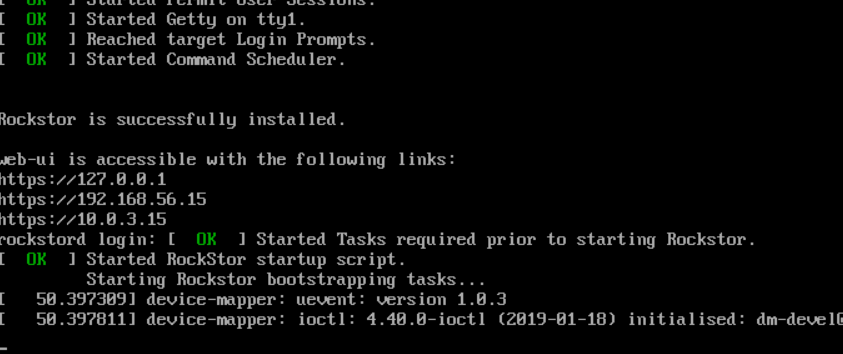I just built the installer image put it on an USB stick and installed rockstor from it. Had no major issues.
As I don’t have a openSuse system, I used docker. That was not completely straight forward, but it worked eventually. Here are the commands I used for anyone interested:
# Important part here is the --privileged flag which is required to make mount --bind /proc ... work
docker run --privileged -it --mount src=/home/marenz/projects/rockstor-installer,target=/rockstor,type=bind opensuse/leap:15.2
zypper addrepo http://download.opensuse.org/repositories/Virtualization:/Appliances:/Builder/openSUSE_Leap_15.2/ appliance-builder
zypper install python3-kiwi btrfsprogs gfxboot
cd /rockstor
kiwi-ng --profile=Leap15.2.x86_64 --type oem system build --description ./ --target-dir installers/
Thank you for the hard work. Will experiment a bit with it.
A few things I noticed in the WebInterface:
- I had the already known error message about some javascript db problem which had no real effects and I think it was gone after a hard-refresh
- Upon enabling services (SMB, NFS), the “enable” switch was not centered after I clicked on it but was then again centered later.
- Enabling Rock-ons first didn’t work. With that I mean, I clicked the switch, it showed the “processing” animation but then stayed on “off”. After a second try it worked.
- When editing a user that has
/bin/nologin as shell, in the edit mask it shows /bin/bash . If you don’t change anything and go back it is still bin/nologin in the overview.
Tiny details like that make it feel a bit unpolished. But none of those are actual problems…
I am now gonna try to setup jellyfin as a rock-on. Will report my progress (if interest?)
Another detail: I still had the usb stick attached for installing and in the rockstor log I constantly see this error:
[08/Jan/2021 19:49:22] ERROR [storageadmin.views.disk:461] Error running a command. cmd = /usr/sbin/smartctl --info /dev/disk/by-id/usb-Kingston_DataTraveler_2.0_6CF049E31FC2BD4039440109-0:0. rc = 1. stdout = ['smartctl 7.0 2019-05-21 r4917 [x86_64-linux-5.3.18-lp152.57-default] (SUSE RPM)', 'Copyright (C) 2002-18, Bruce Allen, Christian Franke, www.smartmontools.org', '', '/dev/disk/by-id/usb-Kingston_DataTraveler_2.0_6CF049E31FC2BD4039440109-0:0: Unknown USB bridge [0x0951:0x1665 (0x100)]', 'Please specify device type with the -d option.', '', 'Use smartctl -h to get a usage summary', '', '']. stderr = ['']
Traceback (most recent call last):
File "/opt/rockstor/src/rockstor/storageadmin/views/disk.py", line 458, in _update_disk_state
do.name, do.smart_options
File "/opt/rockstor/src/rockstor/system/smart.py", line 338, in available
[SMART, "--info"] + get_dev_options(device, custom_options)
File "/opt/rockstor/src/rockstor/system/osi.py", line 198, in run_command
raise CommandException(cmd, out, err, rc)
CommandException: Error running a command. cmd = /usr/sbin/smartctl --info /dev/disk/by-id/usb-Kingston_DataTraveler_2.0_6CF049E31FC2BD4039440109-0:0. rc = 1. stdout = ['smartctl 7.0 2019-05-21 r4917 [x86_64-linux-5.3.18-lp152.57-default] (SUSE RPM)', 'Copyright (C) 2002-18, Bruce Allen, Christian Franke, www.smartmontools.org', '', '/dev/disk/by-id/usb-Kingston_DataTraveler_2.0_6CF049E31FC2BD4039440109-0:0: Unknown USB bridge [0x0951:0x1665 (0x100)]', 'Please specify device type with the -d option.', '', 'Use smartctl -h to get a usage summary', '', '']. stderr = ['']



